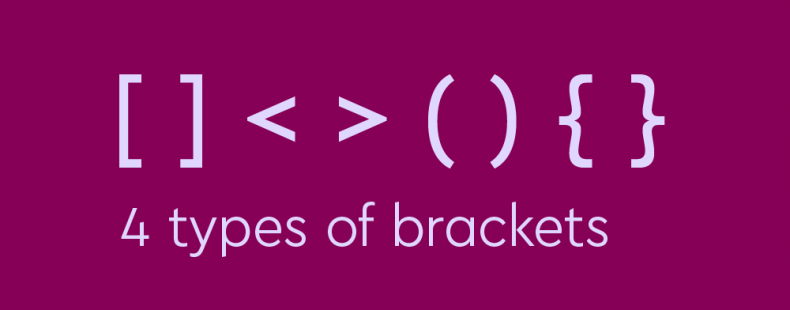When considering punctuation marks, there are four pairs of marks that may be referred to as a type of bracket. They are parentheses, square brackets, curly brackets, and angle brackets. Of these four, parentheses are by far the most commonly used and are the punctuation marks that most writers are likely most familiar with. Although you may not get many chances yourself to bust out a pair of curly brackets or angle brackets, it doesn’t hurt to learn what they are typically used for so they don’t catch you by surprise.
Types of brackets
Parentheses ()
Let’s look at each of the four different types of brackets, moving from the pair you are most likely to see to the pair you will almost never see (in writing, at least).
Despite being the most commonly used of the four types of brackets, parentheses are still less common than other punctuation marks in formal writing. Most writers will tend to use them sparingly but effectively.
Parentheses have a lot of different uses. One particularly common use is to insert additional but unessential information, such as a writer’s commentary, into a sentence.
- Last year, the first pitch was thrown by Santa Claus (yes, really).
- Bananas are good for you (and tasty, too).
Some other information that might be contained within parentheses includes sources, references, abbreviations, acronyms, telephone area codes, and lifespans.
Parentheses examples
- The owners loved dressing their dogs up in funny outfits. (The dogs were much less enthusiastic about it.)
- The cat population doubled over the past 10 years. (Purrcy and Kitchins, 2005)
- The shuttle was built by the National Aeronautics and Space Administration (NASA).
- Edward I of England (1239–1307) was called “Edward Longshanks.”
Know your brackets? Then head over and take our quick quiz on the different types.
Square brackets []
Square brackets, often just called brackets in American English, are typically only used with quotations in formal writing. Square brackets are used to indicate to a reader that the writer added their own words to a quote, added additional context, or otherwise made a change to a quote that wasn’t originally there. The term sic is also often used in a pair of square brackets to indicate that a quote originally had a grammatical error in it, and the writer didn’t make a mistake when reprinting it.
Square bracket examples
The following examples show the different ways that square brackets are typically used with quotations.
- The president said, “He [the Polish ambassador] is a tough negotiator, but I’m confident we will reach an agreement that is best for both countries.”
- The legendary pop singer said that “[she] would come back [to Miami] every summer if [she] could.”
- My textbook says, “The explorers traveled down the Mississipi [sic] River.”
Curly brackets {}
Curly brackets, also known as braces or curly braces, are rarely used in formal writing and are more common in other fields such as science, math, and computing. Some style guides will allow them to be used for one specific purpose: grouping together a set.
- The pastries {cakes, pies, croissants, danishes} looked delicious.
Informally, curly brackets may also be used to attempt to avoid confusion if a writer is using multiple sets of brackets in the same sentence.
- Clifford (a {very, very} big dog) stomped his way down the street.
Both of these uses, though, are rare and many style guides and grammar resources may not have any formal use for curly brackets in writing. It is entirely possible that you may never read anything that uses curly brackets.
Curly bracket examples
The following examples show how curly brackets might be used. Keep in mind that these sentences may not be considered appropriate in formal writing.
- The circus animals {lions, tigers, elephants, monkeys} were very well trained.
- Madame Mysteria (who I {sadly} never met) was a legendary fortune teller.
Angle brackets <>
Angle brackets have no formal use in writing, at least in English. In other languages, double sets of angle brackets are sometimes used in place of quotation marks. Like curly brackets, you are much more likely to see angle brackets used in other fields, such as math and computing.
Informally, angle brackets might be used in place of parentheses to insert asides or you might see them used to introduce a website in an older piece of writing.
Angle bracket examples
The following examples show how angle brackets might be used in writing. These examples would typically not be considered appropriate in formal writing.
- The car was both very fast and very pink. << Much too pink if you ask me >>
- If you’re curious, you can find the rest of Chef Baker’s recipes at <www.bakeittillyoumakeit.yum>
Punctuate perfectly with Grammar Coach™
Confused about punctuation and its proper use? The Thesaurus.com Grammar Coach™ platform makes writing papers, essays, emails, and a whole lot more a whole lot easier. This writing tool uses machine-learning technology uniquely designed to catch grammar as well as spelling errors. Its Synonym Swap will find the best nouns, adjectives, and more to help say what you really mean, guiding you toward clearer, stronger, writing.














